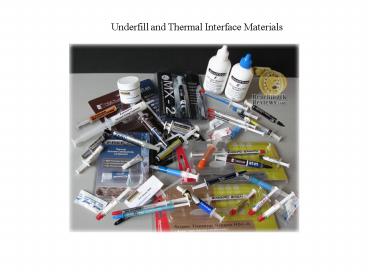Underfill and Thermal Interface Materials - PowerPoint PPT Presentation
1 / 23
Title:
Underfill and Thermal Interface Materials
Description:
these bumps to absorb shocks and prevent the solder joints from ... Thixotropy. Thixotropy is a term which is sometimes used to describe the property of ... – PowerPoint PPT presentation
Number of Views:513
Avg rating:3.0/5.0
Title: Underfill and Thermal Interface Materials
1
Underfill and Thermal Interface Materials
2
In the flipchip system, the integrated circuit
(die or chip) is connected to the
board electrically through a BGA ball grid
array, of solder bumps. Underfill goes between
these bumps to absorb shocks and prevent the
solder joints from breaking and to smooth out
stresses due to thermal expansion
differences. On the top of a microprocessor, a
heat sink removes the excess heat. Thermal
interface material is a grease or adhesive that
carries heat across the gap to the heatsink. In
some chips this can be electrically conductive
and silver can be used, in others not. Heat
control and stress control are major issues in
electronics packaging.
3
High TCE flip chip with underfill
4
Underfill
5
Package empty, with die, closed. Pins go into
the socket on the motherboard
6
Ball grid array
7
(No Transcript)
8
(No Transcript)
9
(No Transcript)
10
(No Transcript)
11
(No Transcript)
12
(No Transcript)
13
(No Transcript)
14
(No Transcript)
15
(No Transcript)
16
A Thermal Interface Material or Mastic (aka TIM)
is used to fill the gaps between thermal transfer
surfaces, such as between microprocessors and
heatsinks, in order to increase thermal transfer
efficiency. These gaps are normally filled with
air which is a very poor conductor. They take
many forms. The most common is the white-colored
paste or thermal grease, typically silicone oil
filled with aluminum oxide, zinc oxide, or boron
nitride. Some brands of thermal interfaces use
micronized or pulverized silver. Another type of
TIM are the phase-change materials. These are
solid at room temperature but liquefy and behave
like grease at operating temperatures. They are
easy to handle and are not messy.
17
With Emerson Cuming TIMs, the interfaces in a
thermal path are efficiently addressed with low
resistance solutions while the adhesive functions
allow elimination of bulky clamps or other
mechanical devices. In addition, high metal
content in the electrically conductive TIMs
enable solid ground paths without the need for
separate solder joints or busbars. Alternatively,
the dielectric filled TIMs provide excellent
electrical insulation where needed.
18
Probably the most critical step in the testing
process was the preparation. Thanks to the team
at Arctic Silver, we were able to clean and
prepare the surface of six brand-new stock Intel
OEM heatsinks and Intel Core 2 Duo E6550 IHS
(Integrated Heat Spreader) to a pristine state
with their ArctiClean products. While these
products are praised by product analysts like
myself, they can be equally as useful for anyone
who frequently separates the cooler from the CPU
or frequently applies TIM material such as
extreme overclockers and hardware
enthusiasts. Thixotropy Thixotropy is a term
which is sometimes used to describe the property
of pseudoplastic fluids to show a time-dependent
change in viscosity the longer the fluid
undergoes shear stress the lower its viscosity.
A thixotropic fluid is a fluid which takes a
finite amount of time to attain equilibrium
viscosity when introduced to a step change in
shear rate. As we see progression in the area of
Thermal Interface Materials, there has become a
substantial increase in the number of
manufacturers who embrace thixotropic TIM's.
Many of these products make up the newest names
on the market, and can be compared to the
revelation that the Heatpipe Direct Touch
technology has seen in the CPU cooler
industry. Even though nearly all of our TIM
products were new, some had been sitting on the
test shelf for a many months. Before each test
the TIM material was mixed and agitated to ensure
proper consistency. Silicon-based TIM's are more
susceptible to the breakdown because of
dissimilar compound bonds, and should always be
mixed prior to use regardless of product age.
Newer carbon-enriched silicon compounds seldom
exhibit breakdown because of their thixotropic
consistency (see definition above). Regardless,
all test samples were aggressively mixed prior to
application onto the CPU cooler. Once the
product was prepared, it was applied onto the
surface in a very thin coating and spread evenly.
19
Test System Motherboard Gigabyte GA-X48T-DQ6
(Intel X48 Chipset) with E BIOS System Memory
Corsair PC3-14400 DDR3 1800MHz (Overclocked to
1844MHz) Processor Intel E6550 Core 2 Duo
2.33GHz (Overclocked to 3.23GHz) Cooling Intel
OEM Aluminum Cooler with Copper Base Video
ZOTAC GeForce 8800 GT 512MB AMP! Graphics
Card Audio HT Omega Claro Plus AD8620BR Op Amp
Sound Card Disk Drive 1 Western Digital 74GB
WD740ADFD 10,000 RPM SATA Disk Drive 2
(Paging File) MemoRight GT MR25.2-064S 2.5-Inch
64GB SATA SSD Optical Drive Samsung SH-S203
SATA 20x DVD R/W Enclosure Lian Li PC-B25B
Black Aluminum Mid-Tower ATX Case PSU
ePower Technology EP-1200P10 xScale 1200W PSU
Monitor SOYO 24-Inch Widescreen LCD Monitor
DYLM24D6 Operating System Windows XP
Professional SP-2 (optimized to 16 processes at
idle)
20
Temperature difference under off, idle and load
conditions for a chip on a heatsink with TIM
21
(No Transcript)
22
(No Transcript)
23
(No Transcript)































